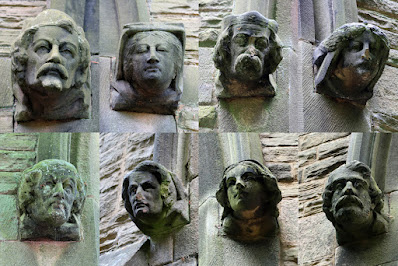 |
| A headstop at the Eckington Cemetery chapel |
As a geologist, I highly value my trips with the Sheffield U3A Geology Group as, not having a car, it enables me to visit spectacular places that I would not be able to easily get to – such as Lathkill Dale and Ashover, which are both renowned field trip locations.
Since the COVID-19 Pandemic lockdown however, travelling by bus from Treeton, when investigating all of the remaining Sheffield Board Schools and taking photographs for the British Listed Buildings website, I have traversed all of the principal sandstone formations between the Chatsworth Grit and the lower part of the Pennine Middle Coal Measures Formation – as well as some of the unnamed sandstones and intervening strata – and have got to know Sheffield’s geology and building stones quite well.
For my next day out, I decided to investigate the listed buildings in Eckington, some of which I had briefly seen a couple of years earlier when visiting the Church of St. Peter and St. Paul. Taking the No. 50 bus from Sheffield, my first stop was the Mosborough Hall Hotel to photograph its Grade II Listed gatepiers, which I had forgotten to do during my previous visit to Mosborough.
Crossing over Sheffield Road, I went to have a quick look at the unlisted Eckington Hall (c1870), which was built for Joseph Wells, the owner of local collieries, but has been converted into apartments. As with the lodge and a large service building, it is built with a rock-faced uniformly yellow/brown, planar bedded sandstone, which is laid in thin courses and contrasts quite strongly with the buff coloured massive sandstone used for the quoins and dressings.
Seen from a distance, the dressings look like they could be a Derbyshire gritstone, such as the Kinderscout Grit from the Stoke Hall quarry, but the walling stone is not familiar to me. The underlying bedrock is the Parkgate Rock which, along with the Silkstone Rock, has been the main source of building stone in south-east Sheffield. My sample of the only outcrop of the Parkgate Rock that I had seen, at Intake, contains several small clay ironstone nodules and older buildings around Mosborough are built in sandstone that varies in colour and has a very high iron content.
According to the geological memoir, the Parkgate Rock in the Sheffield Area is united with the younger Deep Hard Rock, with the former being strongly cross-bedded and containing numerous layers of silty mudstone, with the latter being more massive; however, these formations are very variable in thickness and lateral extent and more often separated by mudstone, coal etc., which the 1:50,000 geological map doesn’t clearly show.
Continuing with my walk down the A6135 road, just beyond Windmill Greenway there is a shallow cutting where a section of very thinly bedded and gently dipping Parkgate Rock is exposed, with the beds and the dry stone wall built upon them being distorted by tree roots in one place.
The lower section contains a lens of more massive sandstone, where there is a very closely spaced pattern of jointing, which I thought was quite unusual. A little further along the exposure, this more massive bed becomes very sandy and more extensively weathered to reveal a distinct orange colour.
Although I didn’t have my Estwing hammer with me, I managed to obtain a small sample from a 30 mm thick bed of the more durable sandstone, which is fine grained and greyish in colour, with its fine cross-bedding being highlighted by iron staining.
My next stop was Eckington Cemetery, where the boundary wall and lodge are built out of a light brown planar bedded sandstone, with a significant amount of dense iron concentrations that is laid in relatively thin courses and which I think is probably Parkgate Rock.
The main purpose was to photograph the Grade II Listed Chapel of Ease (1878), which has become dilapidated and really needs the masonry to be cleaned of general dirt and algae before its possible provenance can be determined, although its general physical characteristics are the same as those of the boundary walls and lodge.
Of particular interest was the massive red sandstone that has been used for the various dressings, which looks like the Matlock stone that has been seen in the later Sheffield Board Schools at Pomona Street, Western Road and Ranmoor.
The chapel also has a very fine set of headstops on the various elevations, which are not even mentioned in the Historic England description - as at the Burngreave Cemetery chapels and Victorian churches at Pitsmoor Road, Netherthorpe and Broomhill among others, which have fine examples of stone carving.













No comments:
Post a Comment